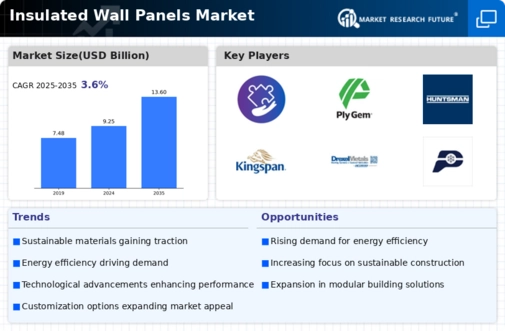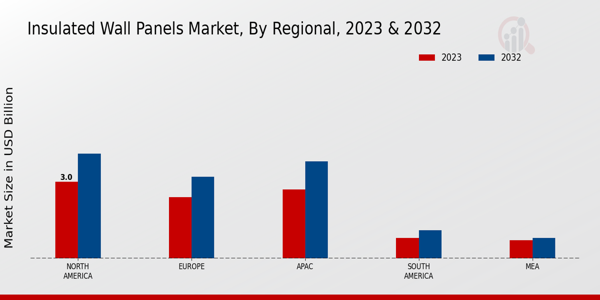Market Growth Projections
The Global Insulated Wall Panels Market Industry is projected to experience substantial growth over the next decade. With a market value of 9.25 USD Billion in 2024, the industry is set to expand as demand for energy-efficient building solutions increases. The anticipated compound annual growth rate of 3.55 percent from 2025 to 2035 suggests a robust market environment driven by various factors, including technological advancements, regulatory support, and a growing emphasis on sustainability. This growth trajectory indicates a promising future for insulated wall panels, positioning them as a key component in modern construction practices.
Growth in Construction Activities
The Global Insulated Wall Panels Market Industry is poised for growth due to the resurgence of construction activities across various sectors, including residential, commercial, and industrial. As urbanization continues to rise globally, there is an increasing need for efficient and sustainable building solutions. Insulated wall panels are particularly attractive in this context, as they offer quick installation and energy efficiency. The construction sector's recovery is expected to boost the demand for insulated wall panels, contributing to the overall market expansion. This growth trajectory is supported by the anticipated market value of 9.25 USD Billion in 2024, reflecting the increasing reliance on these panels in new construction projects.
Sustainable Construction Practices
Sustainability is a key driver in the Global Insulated Wall Panels Market Industry, as more builders and developers prioritize environmentally friendly materials and practices. Insulated wall panels, often made from recyclable materials, align with the growing trend towards sustainable construction. This shift is further supported by government incentives for green building practices, which encourage the use of energy-efficient materials. The adoption of insulated wall panels not only reduces the carbon footprint of buildings but also enhances their overall sustainability profile. As a result, the market is anticipated to grow, reaching an estimated 13.6 USD Billion by 2035, reflecting the increasing integration of sustainability in construction.
Rising Demand for Energy Efficiency
The Global Insulated Wall Panels Market Industry is experiencing a notable increase in demand driven by the global emphasis on energy efficiency. As governments worldwide implement stricter building codes and regulations aimed at reducing energy consumption, insulated wall panels are becoming a preferred choice for construction projects. These panels provide superior thermal insulation, which can significantly lower heating and cooling costs. For instance, buildings utilizing insulated wall panels can achieve energy savings of up to 30 percent compared to traditional construction methods. This trend is expected to contribute to the market's growth, with projections indicating a market value of 9.25 USD Billion in 2024.
Regulatory Support for Energy Efficiency
Regulatory frameworks promoting energy efficiency are a significant driver for the Global Insulated Wall Panels Market Industry. Governments around the world are enacting policies that mandate energy-efficient building practices, which directly impacts the demand for insulated wall panels. These regulations often include energy performance standards that require new buildings to meet specific insulation criteria. As a result, builders are increasingly turning to insulated wall panels to comply with these regulations, thereby driving market growth. The ongoing regulatory support is expected to sustain the market's upward trajectory, with projections indicating a market value of 13.6 USD Billion by 2035.
Technological Advancements in Manufacturing
Technological innovations in the manufacturing of insulated wall panels are significantly influencing the Global Insulated Wall Panels Market Industry. Advances in production techniques, such as improved insulation materials and automated manufacturing processes, enhance the performance and cost-effectiveness of these panels. For example, the introduction of advanced foam insulation materials has improved thermal resistance, making insulated wall panels more appealing to builders. These technological improvements not only increase the efficiency of production but also reduce waste, thereby lowering costs. As a result, the market is likely to experience a compound annual growth rate of 3.55 percent from 2025 to 2035, driven by these advancements.













